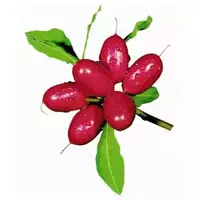Magic fruit

The magic fruit rightfully earned its name thanks to a special property that can be called unique. The fact is that it is able to completely change the perception of taste. However, let's talk about this later, and consider this fruit from the point of view of gastronomy.
The plant, which is an evergreen shrub or a small tree, belongs to the sapotum family. It comes from West Africa. About a month after the end of flowering, shiny bright red berries begin to appear on the shrub, which are elliptical in shape. We can say that they very much resemble the more familiar barberry for us, the length of which hardly exceeds three centimeters.
It is noteworthy that the magic fruit is a rather whimsical fruit regarding its interesting properties. The whole problem is that it is recommended to use it almost immediately after collection, since after a while all its magical qualities are lost.
And they consist in the following: if when eating acidic food (for example, lemons) bite the berry of a magical fruit, this sourness miraculously transforms into an extraordinary sweetness. In addition, replacing lemon with something really sweet, the same berry tricks the taste buds, making the dish taste bitter. The duration of this effect directly depends on the number of berries used, but on average, one fruit acts for about an hour. This is such a wonderful property inherent in magic fruit.
An unusual plant has long haunted numerous scientists and as a result of their research of the magical fruit, they were crowned with success - the phenomenon of this berry was solved. Thus, Keiko Abe, together with his colleagues from the University of Tokyo, created cultures of special cells, thanks to which it became possible to test taste buds at different levels of alkalinity and acidity.
It turned out that a special substance called miraculin, which is found in the fruits of a magic fruit, can bind to receptors responsible for sweet taste. However, unlike the action of aspartame or sugars, these receptors are not able to be activated at neutral pH. The reaction begins only under the condition of an acidic environment - that is, when a product with an acidic taste enters the mouth. Thus, when eating magic fruit together with acidic food, a person has the feeling that he has tasted something unusually sweet.
Therefore, scientists believe that miraculin contained in magic fruit has every chance of becoming one of the ideal sweeteners of natural origin for people suffering from obesity, as well as diabetics. However, in some countries, in particular the United States, it is believed that this natural additive is addictive.
magic fruit 30 kCal
The energy value of magic fruit (Ratio of proteins, fats, carbohydrates - ju):
Proteins: 0 g (~ 0 kCal)
Fats: 0 g (~ 0 kCal)
Carbohydrates: 7.7 g (~ 31 kCal)
Energy ratio (bj | y): 0% | 0% | 103%
 Español
Español Français
Français Português
Português Русский
Русский 简体中文
简体中文 繁體中文
繁體中文 日本語
日本語 한국어
한국어 العربية
العربية Türkçe
Türkçe Қазақ
Қазақ Deutsch
Deutsch Italiano
Italiano Українська
Українська
